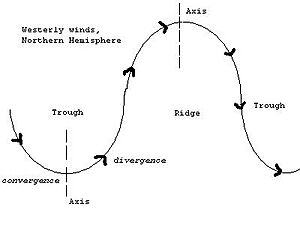Trough (meteorology) facts for kids
A trough is like a long, low dip in the air pressure. Imagine a valley in the atmosphere. Troughs often bring changes in weather, usually with weather fronts.
Sometimes, special clouds called "convective cells" can form around troughs. These cells can even grow into a tropical cyclone, which is a powerful storm. Places like the Philippines or southern China often see these storm-forming cells because of troughs.
In areas where winds blow from west to east (called "westerlies"), troughs and ridges (which are areas of high pressure) often swap places. This happens a lot when the winds high up in the sky have a wavy pattern.
How Troughs Affect Weather
For a trough in the westerlies, the area just west of its center usually has winds that come together. This makes the air sink, which can lead to higher pressure and clearer skies. But the area just east of the trough's center has fast winds that spread out. This causes lower pressure and can bring stormy weather.
Tropical Waves
There's a special kind of trough called a "tropical wave." These waves happen in winds that blow from east to west (called "easterly currents"). A tropical wave can make the normal trade winds bend northward in a swirling, cyclone-like way.
Images for kids
See also
 In Spanish: Vaguada (meteorología) para niños
In Spanish: Vaguada (meteorología) para niños



